A Report on Effective Use of Patient-Care Technologies in Telehealth
VerifiedAdded on 2022/10/31
|7
|1597
|252
Report
AI Summary
This report delves into the effective utilization of patient-care technologies within the realm of telehealth. It explores various technologies, including video conferencing and high-resolution cameras, which facilitate remote communication with patients, especially those with limited mobility. The report also examines Remote Patient Monitoring (RPM) technologies, such as wearables, that enable the collection and transmission of vital health data. Furthermore, it discusses store-and-forward systems, highlighting their role in securely capturing, storing, and transmitting patient information for asynchronous healthcare delivery. The benefits of telehealth, such as increased accessibility to medical professionals and improved patient outcomes, are discussed, along with potential weaknesses, such as cost and the lack of personal interaction. The report emphasizes the importance of technological advancements in educating nurses and improving patient outcomes and highlights the need for advanced educational programs to optimize the benefits of technology across the healthcare continuum.
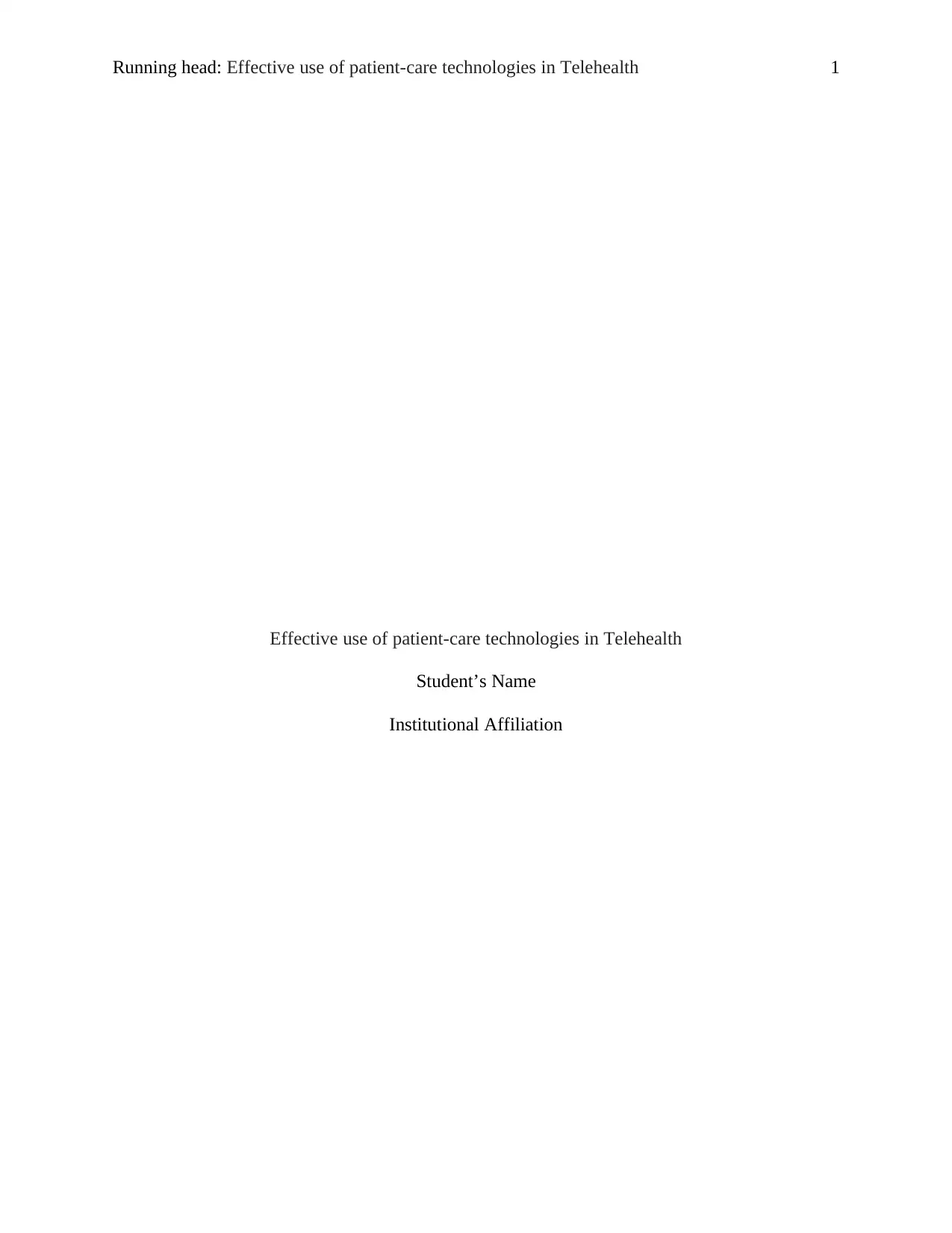
Running head: Effective use of patient-care technologies in Telehealth 1
Effective use of patient-care technologies in Telehealth
Student’s Name
Institutional Affiliation
Effective use of patient-care technologies in Telehealth
Student’s Name
Institutional Affiliation
Paraphrase This Document
Need a fresh take? Get an instant paraphrase of this document with our AI Paraphraser
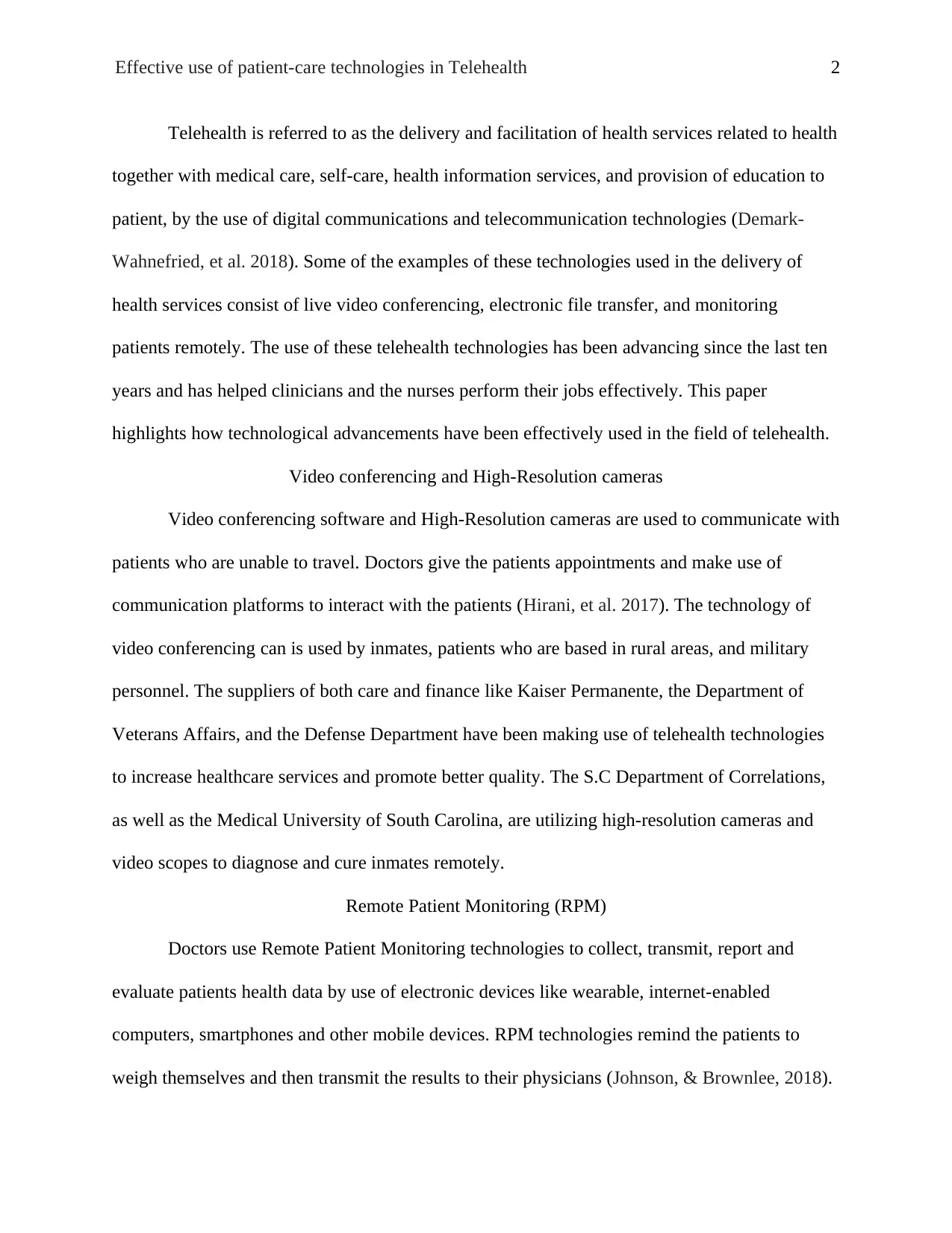
Effective use of patient-care technologies in Telehealth 2
Telehealth is referred to as the delivery and facilitation of health services related to health
together with medical care, self-care, health information services, and provision of education to
patient, by the use of digital communications and telecommunication technologies (Demark‐
Wahnefried, et al. 2018). Some of the examples of these technologies used in the delivery of
health services consist of live video conferencing, electronic file transfer, and monitoring
patients remotely. The use of these telehealth technologies has been advancing since the last ten
years and has helped clinicians and the nurses perform their jobs effectively. This paper
highlights how technological advancements have been effectively used in the field of telehealth.
Video conferencing and High-Resolution cameras
Video conferencing software and High-Resolution cameras are used to communicate with
patients who are unable to travel. Doctors give the patients appointments and make use of
communication platforms to interact with the patients (Hirani, et al. 2017). The technology of
video conferencing can is used by inmates, patients who are based in rural areas, and military
personnel. The suppliers of both care and finance like Kaiser Permanente, the Department of
Veterans Affairs, and the Defense Department have been making use of telehealth technologies
to increase healthcare services and promote better quality. The S.C Department of Correlations,
as well as the Medical University of South Carolina, are utilizing high-resolution cameras and
video scopes to diagnose and cure inmates remotely.
Remote Patient Monitoring (RPM)
Doctors use Remote Patient Monitoring technologies to collect, transmit, report and
evaluate patients health data by use of electronic devices like wearable, internet-enabled
computers, smartphones and other mobile devices. RPM technologies remind the patients to
weigh themselves and then transmit the results to their physicians (Johnson, & Brownlee, 2018).
Telehealth is referred to as the delivery and facilitation of health services related to health
together with medical care, self-care, health information services, and provision of education to
patient, by the use of digital communications and telecommunication technologies (Demark‐
Wahnefried, et al. 2018). Some of the examples of these technologies used in the delivery of
health services consist of live video conferencing, electronic file transfer, and monitoring
patients remotely. The use of these telehealth technologies has been advancing since the last ten
years and has helped clinicians and the nurses perform their jobs effectively. This paper
highlights how technological advancements have been effectively used in the field of telehealth.
Video conferencing and High-Resolution cameras
Video conferencing software and High-Resolution cameras are used to communicate with
patients who are unable to travel. Doctors give the patients appointments and make use of
communication platforms to interact with the patients (Hirani, et al. 2017). The technology of
video conferencing can is used by inmates, patients who are based in rural areas, and military
personnel. The suppliers of both care and finance like Kaiser Permanente, the Department of
Veterans Affairs, and the Defense Department have been making use of telehealth technologies
to increase healthcare services and promote better quality. The S.C Department of Correlations,
as well as the Medical University of South Carolina, are utilizing high-resolution cameras and
video scopes to diagnose and cure inmates remotely.
Remote Patient Monitoring (RPM)
Doctors use Remote Patient Monitoring technologies to collect, transmit, report and
evaluate patients health data by use of electronic devices like wearable, internet-enabled
computers, smartphones and other mobile devices. RPM technologies remind the patients to
weigh themselves and then transmit the results to their physicians (Johnson, & Brownlee, 2018).
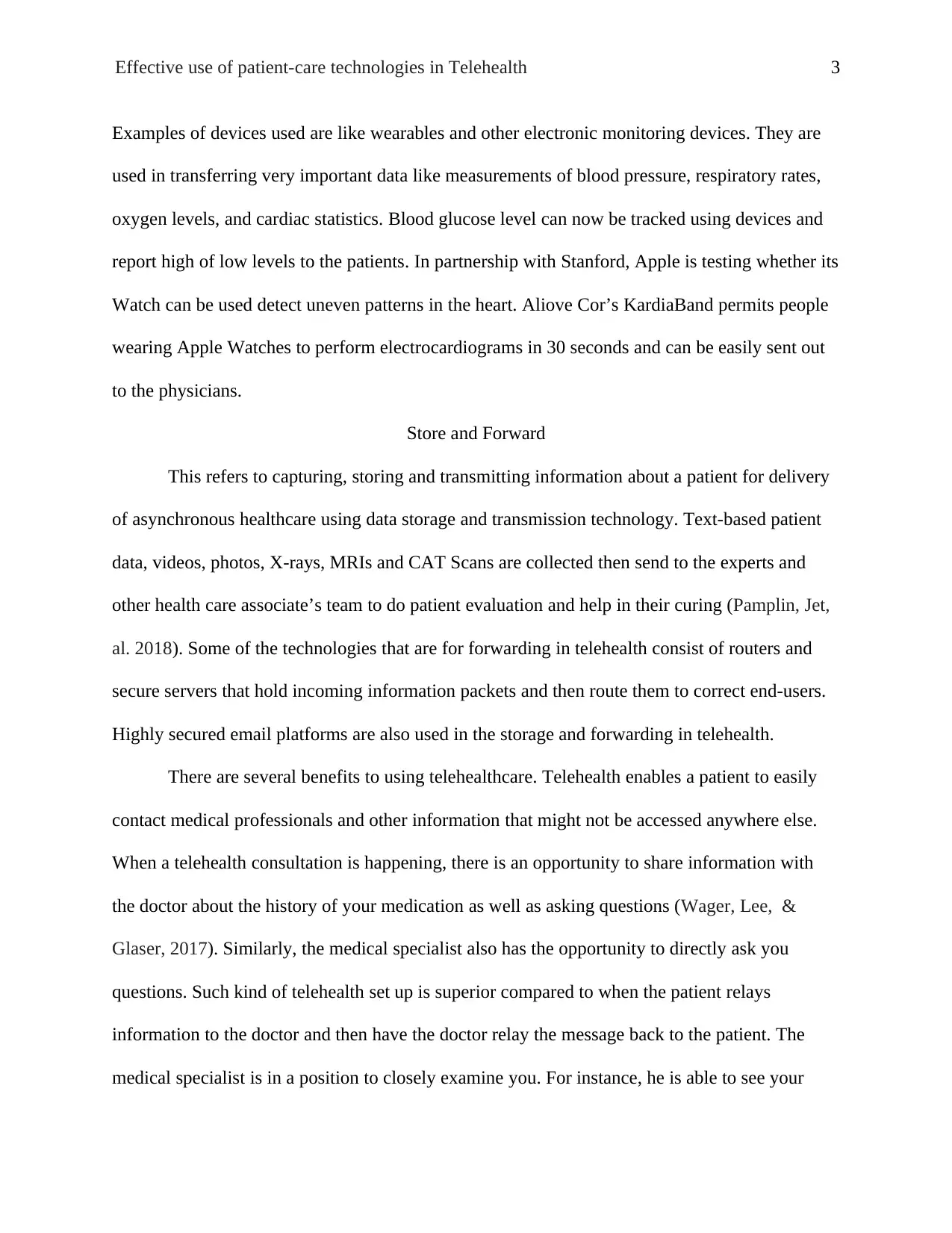
Effective use of patient-care technologies in Telehealth 3
Examples of devices used are like wearables and other electronic monitoring devices. They are
used in transferring very important data like measurements of blood pressure, respiratory rates,
oxygen levels, and cardiac statistics. Blood glucose level can now be tracked using devices and
report high of low levels to the patients. In partnership with Stanford, Apple is testing whether its
Watch can be used detect uneven patterns in the heart. Aliove Cor’s KardiaBand permits people
wearing Apple Watches to perform electrocardiograms in 30 seconds and can be easily sent out
to the physicians.
Store and Forward
This refers to capturing, storing and transmitting information about a patient for delivery
of asynchronous healthcare using data storage and transmission technology. Text-based patient
data, videos, photos, X-rays, MRIs and CAT Scans are collected then send to the experts and
other health care associate’s team to do patient evaluation and help in their curing (Pamplin, Jet,
al. 2018). Some of the technologies that are for forwarding in telehealth consist of routers and
secure servers that hold incoming information packets and then route them to correct end-users.
Highly secured email platforms are also used in the storage and forwarding in telehealth.
There are several benefits to using telehealthcare. Telehealth enables a patient to easily
contact medical professionals and other information that might not be accessed anywhere else.
When a telehealth consultation is happening, there is an opportunity to share information with
the doctor about the history of your medication as well as asking questions (Wager, Lee, &
Glaser, 2017). Similarly, the medical specialist also has the opportunity to directly ask you
questions. Such kind of telehealth set up is superior compared to when the patient relays
information to the doctor and then have the doctor relay the message back to the patient. The
medical specialist is in a position to closely examine you. For instance, he is able to see your
Examples of devices used are like wearables and other electronic monitoring devices. They are
used in transferring very important data like measurements of blood pressure, respiratory rates,
oxygen levels, and cardiac statistics. Blood glucose level can now be tracked using devices and
report high of low levels to the patients. In partnership with Stanford, Apple is testing whether its
Watch can be used detect uneven patterns in the heart. Aliove Cor’s KardiaBand permits people
wearing Apple Watches to perform electrocardiograms in 30 seconds and can be easily sent out
to the physicians.
Store and Forward
This refers to capturing, storing and transmitting information about a patient for delivery
of asynchronous healthcare using data storage and transmission technology. Text-based patient
data, videos, photos, X-rays, MRIs and CAT Scans are collected then send to the experts and
other health care associate’s team to do patient evaluation and help in their curing (Pamplin, Jet,
al. 2018). Some of the technologies that are for forwarding in telehealth consist of routers and
secure servers that hold incoming information packets and then route them to correct end-users.
Highly secured email platforms are also used in the storage and forwarding in telehealth.
There are several benefits to using telehealthcare. Telehealth enables a patient to easily
contact medical professionals and other information that might not be accessed anywhere else.
When a telehealth consultation is happening, there is an opportunity to share information with
the doctor about the history of your medication as well as asking questions (Wager, Lee, &
Glaser, 2017). Similarly, the medical specialist also has the opportunity to directly ask you
questions. Such kind of telehealth set up is superior compared to when the patient relays
information to the doctor and then have the doctor relay the message back to the patient. The
medical specialist is in a position to closely examine you. For instance, he is able to see your
⊘ This is a preview!⊘
Do you want full access?
Subscribe today to unlock all pages.

Trusted by 1+ million students worldwide
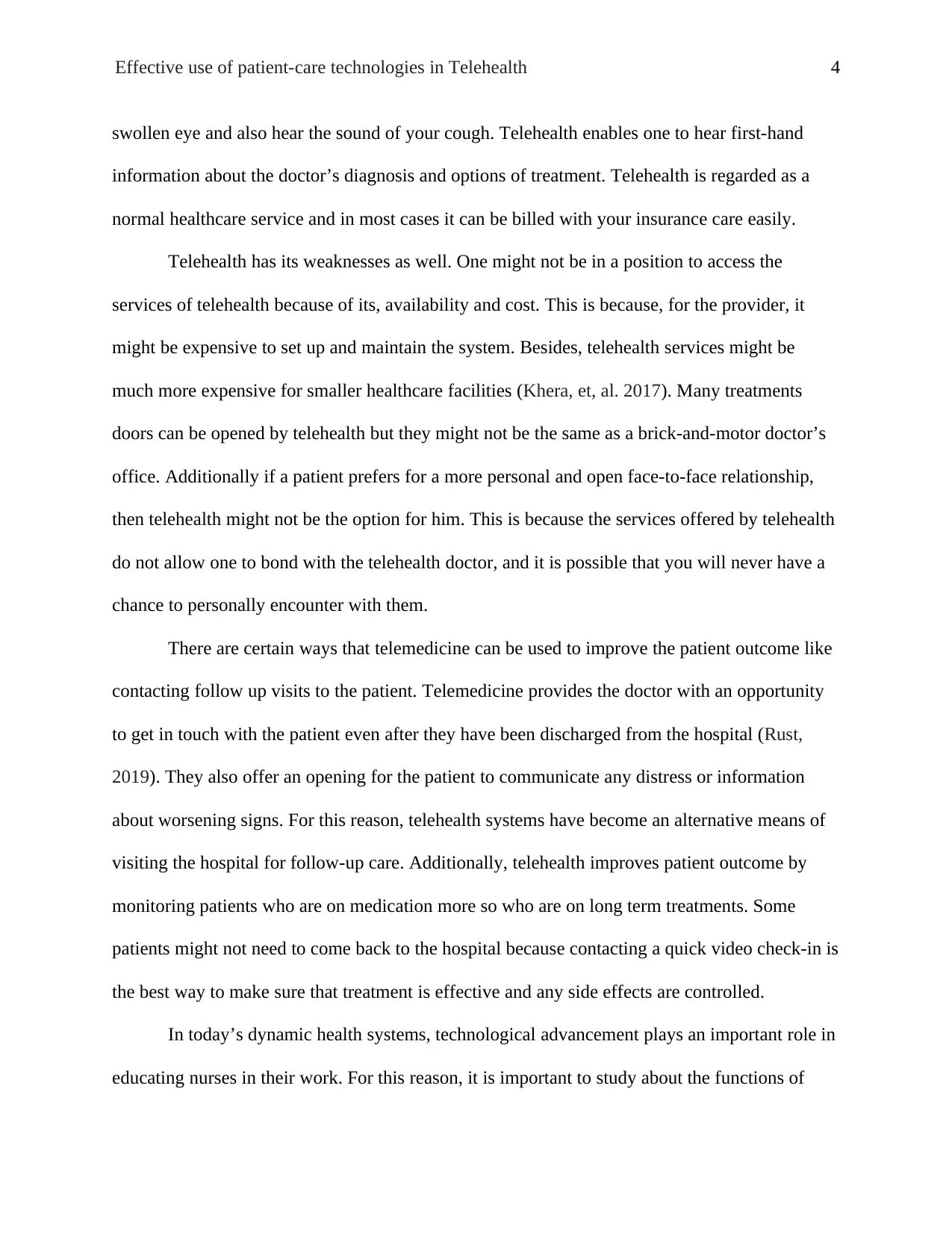
Effective use of patient-care technologies in Telehealth 4
swollen eye and also hear the sound of your cough. Telehealth enables one to hear first-hand
information about the doctor’s diagnosis and options of treatment. Telehealth is regarded as a
normal healthcare service and in most cases it can be billed with your insurance care easily.
Telehealth has its weaknesses as well. One might not be in a position to access the
services of telehealth because of its, availability and cost. This is because, for the provider, it
might be expensive to set up and maintain the system. Besides, telehealth services might be
much more expensive for smaller healthcare facilities (Khera, et, al. 2017). Many treatments
doors can be opened by telehealth but they might not be the same as a brick-and-motor doctor’s
office. Additionally if a patient prefers for a more personal and open face-to-face relationship,
then telehealth might not be the option for him. This is because the services offered by telehealth
do not allow one to bond with the telehealth doctor, and it is possible that you will never have a
chance to personally encounter with them.
There are certain ways that telemedicine can be used to improve the patient outcome like
contacting follow up visits to the patient. Telemedicine provides the doctor with an opportunity
to get in touch with the patient even after they have been discharged from the hospital (Rust,
2019). They also offer an opening for the patient to communicate any distress or information
about worsening signs. For this reason, telehealth systems have become an alternative means of
visiting the hospital for follow-up care. Additionally, telehealth improves patient outcome by
monitoring patients who are on medication more so who are on long term treatments. Some
patients might not need to come back to the hospital because contacting a quick video check-in is
the best way to make sure that treatment is effective and any side effects are controlled.
In today’s dynamic health systems, technological advancement plays an important role in
educating nurses in their work. For this reason, it is important to study about the functions of
swollen eye and also hear the sound of your cough. Telehealth enables one to hear first-hand
information about the doctor’s diagnosis and options of treatment. Telehealth is regarded as a
normal healthcare service and in most cases it can be billed with your insurance care easily.
Telehealth has its weaknesses as well. One might not be in a position to access the
services of telehealth because of its, availability and cost. This is because, for the provider, it
might be expensive to set up and maintain the system. Besides, telehealth services might be
much more expensive for smaller healthcare facilities (Khera, et, al. 2017). Many treatments
doors can be opened by telehealth but they might not be the same as a brick-and-motor doctor’s
office. Additionally if a patient prefers for a more personal and open face-to-face relationship,
then telehealth might not be the option for him. This is because the services offered by telehealth
do not allow one to bond with the telehealth doctor, and it is possible that you will never have a
chance to personally encounter with them.
There are certain ways that telemedicine can be used to improve the patient outcome like
contacting follow up visits to the patient. Telemedicine provides the doctor with an opportunity
to get in touch with the patient even after they have been discharged from the hospital (Rust,
2019). They also offer an opening for the patient to communicate any distress or information
about worsening signs. For this reason, telehealth systems have become an alternative means of
visiting the hospital for follow-up care. Additionally, telehealth improves patient outcome by
monitoring patients who are on medication more so who are on long term treatments. Some
patients might not need to come back to the hospital because contacting a quick video check-in is
the best way to make sure that treatment is effective and any side effects are controlled.
In today’s dynamic health systems, technological advancement plays an important role in
educating nurses in their work. For this reason, it is important to study about the functions of
Paraphrase This Document
Need a fresh take? Get an instant paraphrase of this document with our AI Paraphraser

Effective use of patient-care technologies in Telehealth 5
nurses and emphasize on the need for good technological information programs so that they can
work well with the advancing rate of technology in medicine (Taylor, et, al. 2015). In order to
effectively fully benefit and realize increased patient outcome from the technological
advancement, there is need for advanced educational arrangement to set a short-term and long-
term specialized courses focusing on this four target groups studying working, graduate, senior
undergraduate, and undergraduate doctoral. The main purpose of doing would be to help in
program development.
nurses and emphasize on the need for good technological information programs so that they can
work well with the advancing rate of technology in medicine (Taylor, et, al. 2015). In order to
effectively fully benefit and realize increased patient outcome from the technological
advancement, there is need for advanced educational arrangement to set a short-term and long-
term specialized courses focusing on this four target groups studying working, graduate, senior
undergraduate, and undergraduate doctoral. The main purpose of doing would be to help in
program development.
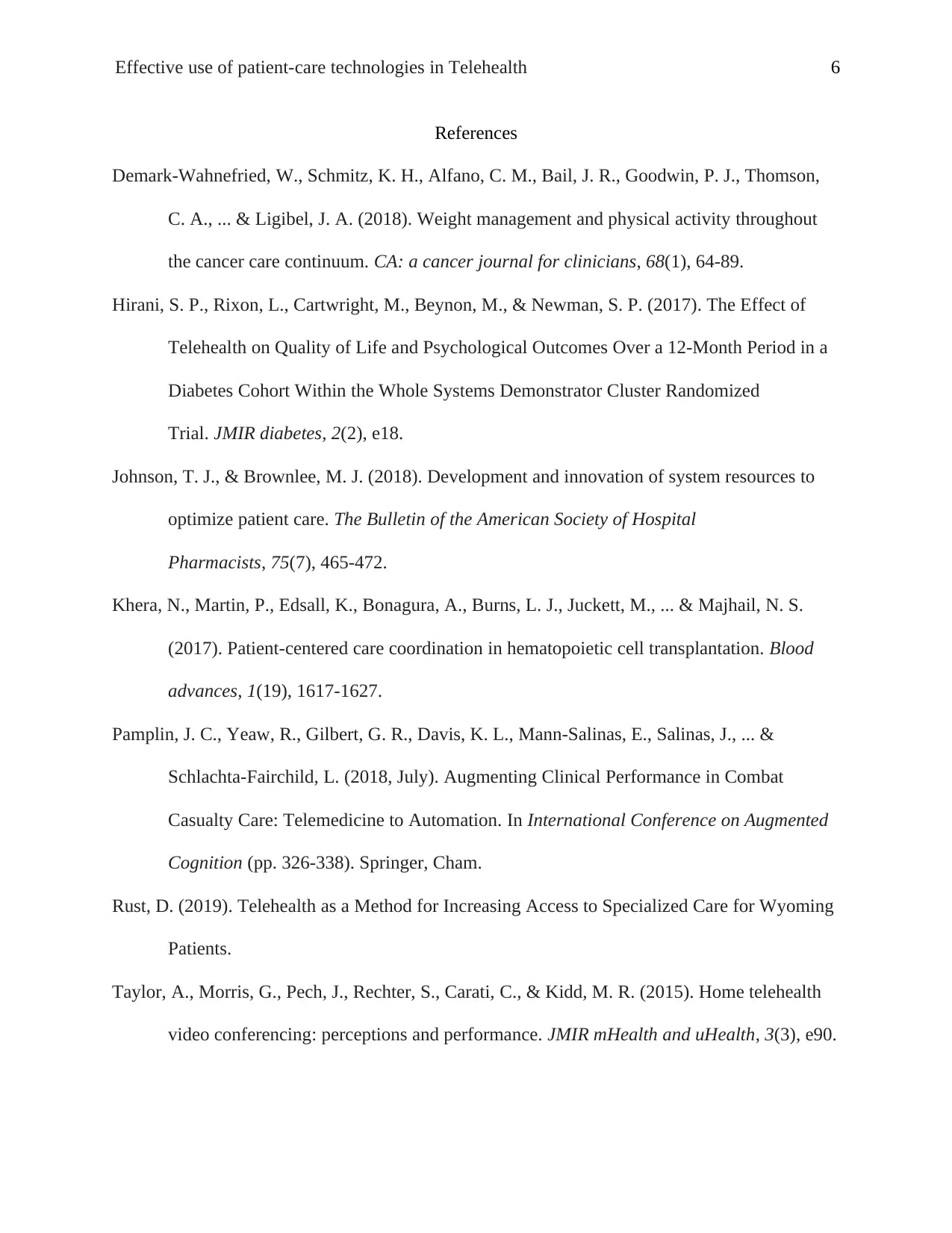
Effective use of patient-care technologies in Telehealth 6
References
Demark‐Wahnefried, W., Schmitz, K. H., Alfano, C. M., Bail, J. R., Goodwin, P. J., Thomson,
C. A., ... & Ligibel, J. A. (2018). Weight management and physical activity throughout
the cancer care continuum. CA: a cancer journal for clinicians, 68(1), 64-89.
Hirani, S. P., Rixon, L., Cartwright, M., Beynon, M., & Newman, S. P. (2017). The Effect of
Telehealth on Quality of Life and Psychological Outcomes Over a 12-Month Period in a
Diabetes Cohort Within the Whole Systems Demonstrator Cluster Randomized
Trial. JMIR diabetes, 2(2), e18.
Johnson, T. J., & Brownlee, M. J. (2018). Development and innovation of system resources to
optimize patient care. The Bulletin of the American Society of Hospital
Pharmacists, 75(7), 465-472.
Khera, N., Martin, P., Edsall, K., Bonagura, A., Burns, L. J., Juckett, M., ... & Majhail, N. S.
(2017). Patient-centered care coordination in hematopoietic cell transplantation. Blood
advances, 1(19), 1617-1627.
Pamplin, J. C., Yeaw, R., Gilbert, G. R., Davis, K. L., Mann-Salinas, E., Salinas, J., ... &
Schlachta-Fairchild, L. (2018, July). Augmenting Clinical Performance in Combat
Casualty Care: Telemedicine to Automation. In International Conference on Augmented
Cognition (pp. 326-338). Springer, Cham.
Rust, D. (2019). Telehealth as a Method for Increasing Access to Specialized Care for Wyoming
Patients.
Taylor, A., Morris, G., Pech, J., Rechter, S., Carati, C., & Kidd, M. R. (2015). Home telehealth
video conferencing: perceptions and performance. JMIR mHealth and uHealth, 3(3), e90.
References
Demark‐Wahnefried, W., Schmitz, K. H., Alfano, C. M., Bail, J. R., Goodwin, P. J., Thomson,
C. A., ... & Ligibel, J. A. (2018). Weight management and physical activity throughout
the cancer care continuum. CA: a cancer journal for clinicians, 68(1), 64-89.
Hirani, S. P., Rixon, L., Cartwright, M., Beynon, M., & Newman, S. P. (2017). The Effect of
Telehealth on Quality of Life and Psychological Outcomes Over a 12-Month Period in a
Diabetes Cohort Within the Whole Systems Demonstrator Cluster Randomized
Trial. JMIR diabetes, 2(2), e18.
Johnson, T. J., & Brownlee, M. J. (2018). Development and innovation of system resources to
optimize patient care. The Bulletin of the American Society of Hospital
Pharmacists, 75(7), 465-472.
Khera, N., Martin, P., Edsall, K., Bonagura, A., Burns, L. J., Juckett, M., ... & Majhail, N. S.
(2017). Patient-centered care coordination in hematopoietic cell transplantation. Blood
advances, 1(19), 1617-1627.
Pamplin, J. C., Yeaw, R., Gilbert, G. R., Davis, K. L., Mann-Salinas, E., Salinas, J., ... &
Schlachta-Fairchild, L. (2018, July). Augmenting Clinical Performance in Combat
Casualty Care: Telemedicine to Automation. In International Conference on Augmented
Cognition (pp. 326-338). Springer, Cham.
Rust, D. (2019). Telehealth as a Method for Increasing Access to Specialized Care for Wyoming
Patients.
Taylor, A., Morris, G., Pech, J., Rechter, S., Carati, C., & Kidd, M. R. (2015). Home telehealth
video conferencing: perceptions and performance. JMIR mHealth and uHealth, 3(3), e90.
⊘ This is a preview!⊘
Do you want full access?
Subscribe today to unlock all pages.

Trusted by 1+ million students worldwide
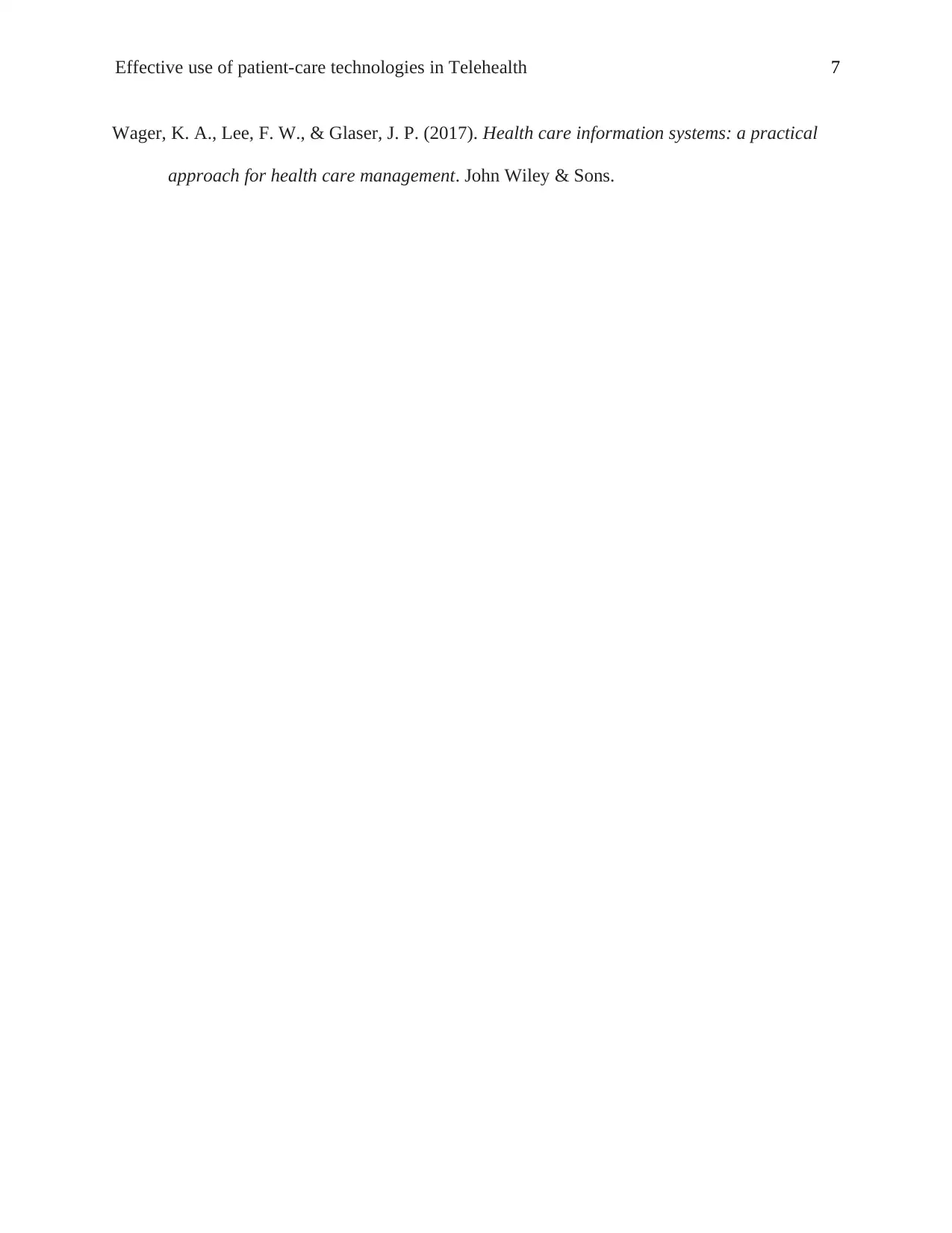
Effective use of patient-care technologies in Telehealth 7
Wager, K. A., Lee, F. W., & Glaser, J. P. (2017). Health care information systems: a practical
approach for health care management. John Wiley & Sons.
Wager, K. A., Lee, F. W., & Glaser, J. P. (2017). Health care information systems: a practical
approach for health care management. John Wiley & Sons.
1 out of 7
Related Documents
Your All-in-One AI-Powered Toolkit for Academic Success.
+13062052269
info@desklib.com
Available 24*7 on WhatsApp / Email
![[object Object]](/_next/static/media/star-bottom.7253800d.svg)
Unlock your academic potential
Copyright © 2020–2025 A2Z Services. All Rights Reserved. Developed and managed by ZUCOL.




